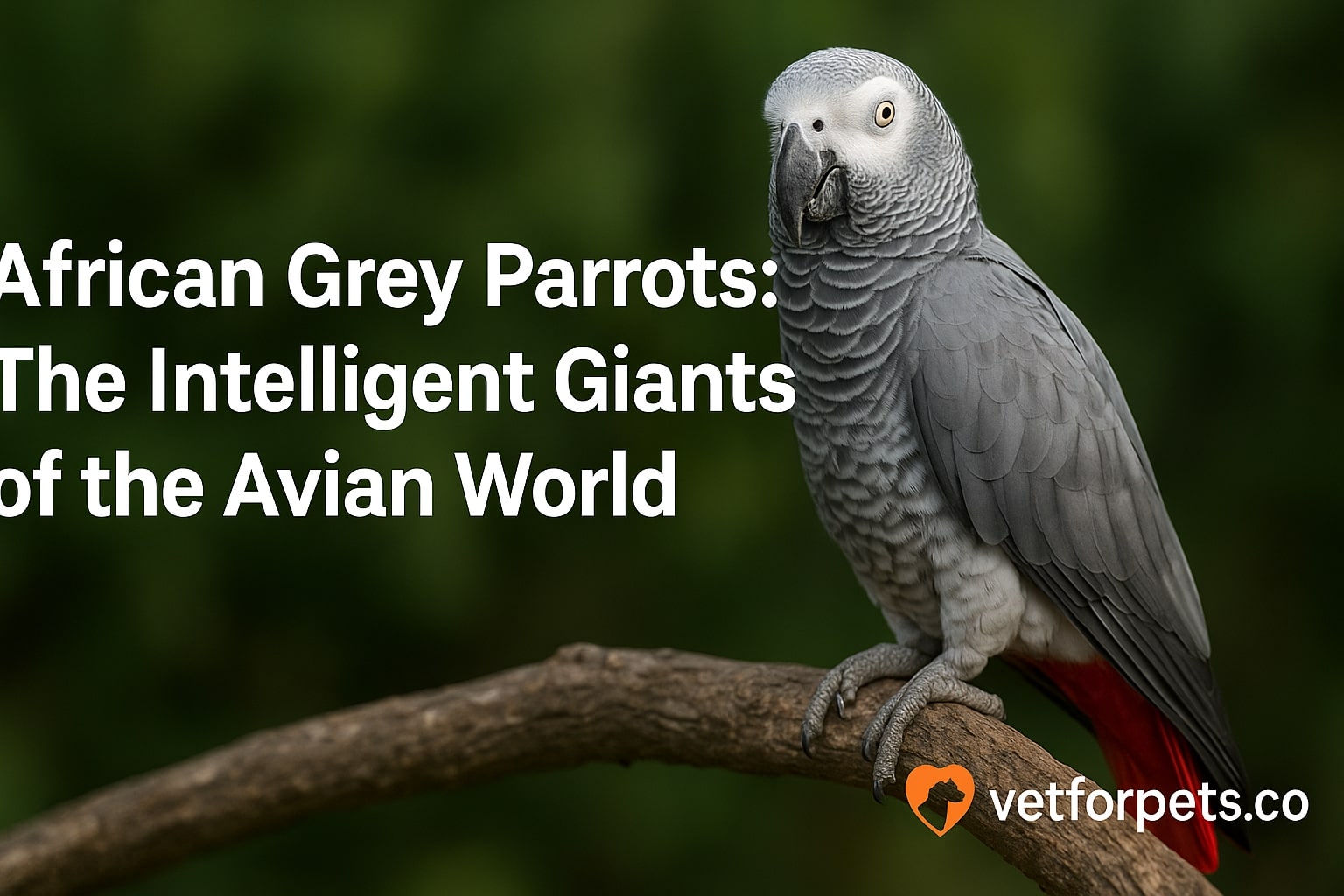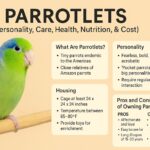African Grey Parrots stand among the most remarkable and intelligent bird species on our planet, captivating bird enthusiasts and researchers alike with their extraordinary cognitive abilities and complex social behaviors.
These magnificent birds, native to the tropical rainforests of equatorial Africa, have earned their reputation as exceptional mimics of human speech while demonstrating problem-solving skills that rival those of young children.
With two distinct subspecies inhabiting different regions of Africa, these parrots face mounting challenges from habitat destruction and the international pet trade, making their conservation increasingly critical for maintaining biodiversity in African ecosystems.
Physical Characteristics and Distinctive Features
African Grey Parrots are truly impressive birds that command attention with their striking appearance and substantial size. These remarkable creatures grow to be up to 13 inches in length, making them Africa’s largest parrot species1.
Their distinctive plumage showcases various shades of grey that create a sophisticated and elegant appearance, with coloring typically appearing slightly darker on the wings and back. The most dramatic feature of their appearance is undoubtedly their vibrant crimson tail, which provides a stunning contrast against their grey feathers and serves as one of their most recognizable characteristics.
The anatomy of African Grey Parrots reflects their adaptation to life in the forest canopy. Like most members of the parrot family, they possess a hooked beak that demonstrates incredible strength, allowing them to crack open tough nuts and seeds that form a significant portion of their natural diet.
This powerful beak serves multiple purposes beyond feeding, including climbing, manipulating objects, and even as a tool for communication through various clicking and grinding sounds.
Their robust build and strong claws make them excellent climbers, preferring to move from branch to branch rather than flying when foraging for food. This climbing behavior demonstrates their energy-efficient approach to navigating their forest habitat while searching for the seeds, nuts, fruits, and berries that sustain them in the wild.
Species Variations: Understanding Congo and Timneh African Greys
The African Grey Parrot family consists of two distinct subspecies that exhibit notable differences in size, appearance, and personality traits. The Timneh and Congo are the only two subspecies of the grey parrot, and while they share many similarities, several key differences help distinguish between them.
The Congo African Grey represents the larger of the two subspecies, measuring approximately 10-15 inches tall and weighing between 15-20 ounces. These birds display a significantly lighter grey coloration throughout their medium grey feathers, with the characteristic bright red tail feathers that make them instantly recognizable. Their beaks typically appear black, providing another distinguishing feature that helps identify this subspecies.
In contrast, the Timneh African Grey presents a more compact appearance, averaging between 6-10 inches tall and weighing 10-15 ounces. The most noticeable difference lies in their much darker charcoal grey coloring, particularly evident on the head, back, and upper chest.
These darker feathers create a distinct V-shaped pattern at the upper chest, where lighter feathers begin to cover the abdomen. The Timneh’s tail feathers display a noticeably duller and darker maroon color compared to the bright red of the Congo variety. Additionally, their beaks feature a light pink coloration on top rather than the black seen in Congo Greys.
The scalloped pattern of white feathers on the head appears more defined in Timneh parrots compared to their Congo cousins. These physical differences extend beyond mere appearance, as each subspecies also demonstrates distinct personality traits and behavioral patterns that influence their suitability as companions and their survival strategies in the wild.
Natural Habitat and Geographic Distribution
African Grey Parrots inhabit a vast range across equatorial Africa, demonstrating remarkable adaptability to various forest environments. Their native range stretches from the eastern part of the Ivory Coast in West Africa to Kenya in East Africa, encompassing numerous countries including Angola, Burundi, Cameroon, Central African Republic, Congo, Democratic Republic of Congo, Côte d’Ivoire, Equatorial Guinea, Gabon, Ghana, Kenya, and Uganda.
These parrots show particular abundance in countries like Gabon and the Congo, where extensive dense rainforests provide ideal conditions for their survival and reproduction. The primary habitat preference centers on lowland rainforests throughout western and central Africa, though they demonstrate adaptability by also inhabiting forest edges, gallery forests that run alongside streams or rivers, and even gardens when suitable food sources are available.
The diversity of environments that support African Grey populations includes several distinct biomes. Dense rainforests provide the thick canopy coverage that offers ideal conditions, with abundant food sources such as fruits, seeds, and nuts, numerous nesting sites in tall trees, and protective cover from predators and harsh weather conditions. Mangrove forests in coastal regions create unique ecosystems where saltwater and freshwater systems meet, offering rich food resources and serving as havens away from more densely populated inland forests.
Gallery and savanna forests provide additional habitat options, while tropical dry forests offer suitable nesting sites and various fruit-bearing trees that contribute to their dietary needs. Even tropical savannas occasionally support African Grey populations, where these adaptable birds adjust to open, grassy environments scattered with trees.
The birds demonstrate strong roosting behaviors, moving away from feeding areas at night to gather in communal roosts. It is common to observe over 100 birds perched together in a single tree, preferring to roost high up in treetops, with a particular preference for oil palm fronds. This gregarious roosting behavior provides safety in numbers and facilitates social interactions that are crucial for their complex social structures.
Diet and Feeding Behavior
African Grey Parrots maintain a strictly vegetarian diet that reflects their role as important seed dispersers in African forest ecosystems. Their feeding behavior demonstrates remarkable patience and skill as they climb methodically from branch to branch, collecting seeds, nuts, fruits, and berries rather than simply flying between food sources.
These intelligent birds show particular fondness for specific food items that provide essential nutrients for their active lifestyle. They especially enjoy eating the outer layer of oil palm nuts, which provides important fats and proteins necessary for their energy needs. The red berries from Cola tragacantha represent another preferred food source that contributes to their varied diet.
Unfortunately, their dietary preferences sometimes bring them into conflict with human agricultural activities. African Greys have developed a taste for grain crops and can cause significant damage to maize plantations in western Africa.
This crop raiding behavior creates tension between conservation efforts and local farming communities, highlighting the complex challenges involved in protecting these birds while supporting human livelihoods.
The foraging behavior of African Greys requires considerable intelligence and memory, as they must remember the locations of various food sources throughout their territory and time their visits to coincide with peak ripeness or availability. This cognitive mapping ability demonstrates their sophisticated mental capabilities and contributes to their reputation as one of the most intelligent bird species.
Behavioral Characteristics and Exceptional Intelligence
African Grey Parrots possess an uncanny ability to mimic human speech that has fascinated researchers and pet owners for generations. This remarkable talent extends far beyond simple repetition, as these birds demonstrate understanding of context, emotion, and even basic concepts related to the words they speak.
Their communication systems in the wild involve complex vocalizations, including high-pitched screams and clear whistles that facilitate coordination within flocks and territory establishment. These natural communication abilities provide the foundation for their exceptional capacity to learn and reproduce human speech patterns with remarkable clarity and accuracy.
The social structure of African Grey Parrots reveals sophisticated relationship dynamics. While limited information exists about wild courtship behaviors, research confirms that they maintain monogamous pair bonds.
During breeding season, females typically lay clutches of two to four eggs, with the female handling incubation duties alone while her mate provides food and protection1. After hatching, both parents participate in caring for the chicks, demonstrating shared parental responsibilities that strengthen pair bonds and improve offspring survival rates.
Their intelligence manifests in numerous ways beyond vocal mimicry. African Greys demonstrate problem-solving abilities, tool use, and emotional intelligence that places them among the most cognitively advanced bird species. They can learn to associate words with objects, understand basic numerical concepts, and even express preferences and emotions through their vocalizations.
Health Concerns and Common Diseases
African Grey Parrots face various health challenges that require careful attention from both wild populations and captive birds. Nutritional deficiencies represent one of the most common health issues, particularly vitamin A and calcium deficiencies, that can lead to serious complications, including kidney failure and muscle weakness.
Excessive food intake, especially diets high in carbohydrates and fats, can result in fatty deposits and compromised organ function. Wild birds naturally maintain balanced diets through their varied foraging behavior, but captive birds often require carefully managed nutrition to prevent these issues.
Toxin exposure poses significant risks to African Grey Parrots due to their sensitive respiratory systems and curious nature. They are vulnerable to ingesting poisons like avocado and heavy metals, including zinc and lead, which can cause gastrointestinal and nervous system problems.
Inhaled toxins such as carbon monoxide or paint fumes can cause respiratory complications due to their highly efficient but sensitive respiratory systems.
Viral diseases present serious threats to African Grey populations. Polyomavirus commonly affects young parrots, often leading to sudden death or abnormal feather development in survivors. Circovirus causes Psittacine Beak and Feather Disease (PBFD), resulting in feather deformities and immune system damage.
Avian Bornavirus is responsible for Macaw Wasting Disease (PDD), a devastating illness affecting the nerves controlling the stomach and leading to digestive issues and weight loss.
Psittacosis, also known as parrot fever, represents a zoonotic disease that can affect both birds and humans. This bacterial infection, caused by Chlamydia psittaci can be contracted from infected parrots and presents as flu-like symptoms in humans with an incubation period of 5-19 days.
The disease can progress to serious pneumonia in severe cases, though fatal outcomes remain rare, occurring in less than 1% of infections.
Conservation Status and Environmental Threats
The conservation status of African Grey Parrots has become increasingly concerning as multiple factors threaten their long-term survival. In 2007, the species became listed as ‘near threatened’ primarily due to their popularity in the international pet trade.
These remarkable birds have become the most popular avian pets in Europe, the United States, and the Middle East, driven by their incredible ability to mimic human speech and their impressive lifespans.
The scale of harvesting for the pet trade represents a significant threat to wild populations. Current estimates suggest that up to 21% of the global African Grey population is harvested annually for the pet trade. This level of extraction is unsustainable for any wild species and creates severe pressure on breeding populations across their native range.
Habitat loss compounds the challenges facing African Grey Parrots as ongoing deforestation throughout Africa eliminates the dense rainforest environments these birds require for nesting, feeding, and roosting. The combination of habitat destruction and intensive harvesting for the pet trade is causing a moderately rapid decline in population numbers across their entire range.
Climate change adds another layer of complexity to conservation efforts, as shifting rainfall patterns and temperature changes affect the forest ecosystems that support African Grey populations. Changes in fruit and seed production timing can disrupt their feeding cycles, while altered weather patterns may affect their breeding success.
Conservation Efforts and Future Outlook
Protecting African Grey Parrots requires coordinated international efforts addressing both the pet trade and habitat conservation. Stronger enforcement of international wildlife trade regulations, education campaigns about the impacts of wild bird capture, and development of sustainable ecotourism programs could help reduce pressure on wild populations while providing economic alternatives for local communities.
Habitat protection remains crucial for long-term conservation success. Establishing and maintaining protected areas that encompass critical breeding and feeding habitats, implementing sustainable forestry practices, and supporting reforestation efforts in degraded areas all contribute to creating secure environments for African Grey populations.
Captive breeding programs offer hope for maintaining genetic diversity and potentially supplementing wild populations in the future. However, these programs must be carefully managed to ensure genetic health and maintain the behavioral characteristics that make these birds successful in their natural environments.
Conclusion
African Grey Parrots represent one of nature’s most remarkable examples of avian intelligence and adaptability. Their exceptional cognitive abilities, complex social behaviors, and important ecological roles as seed dispersers make them invaluable components of African forest ecosystems. However, the mounting pressures from habitat destruction and the international pet trade threaten their long-term survival across their native range.
The future of African Grey Parrots depends on our collective commitment to conservation action. By supporting habitat protection initiatives, enforcing wildlife trade regulations, and promoting sustainable alternatives to wild bird capture, we can help ensure that future generations will continue to marvel at these extraordinary birds in their natural environments.
The intelligence and beauty of African Grey Parrots serve as powerful reminders of the incredible diversity of life that depends on our stewardship of the natural world.
Their story illustrates both the resilience of nature and the profound impact human activities can have on wildlife populations. As we face an uncertain environmental future, the conservation of species like the African Grey Parrot becomes not just an environmental imperative, but a moral obligation to preserve the remarkable creatures that share our planet.
- Parrotlets (Personality, Care, Health, Nutrition, & Cost) - June 20, 2025
- Caique (Personality, Care, Health, & Nutrition) - June 20, 2025
- The Complete Guide to Golden Retrievers - June 9, 2025















